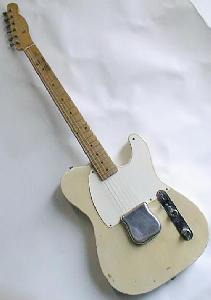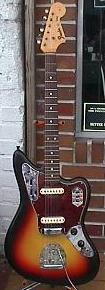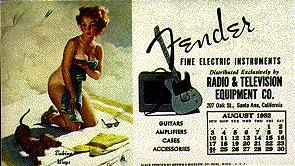
| Electric Model Info: | Schematics: |
Esquire, Esquire Custom.
Collectibility Rating: 1950’s models: B, 1960 models: C (due to it’s single pickup design, it’s rating is lower than a Telecaster).
When first announced in June of 1950 (but available a bit earlier) as Fender’s first electric solidbody, the Esquire was a available with either one or two pickups (actually the “single Esquire” with one pickup was available first), a black pine laminated body, a white pickguard, steel bridge saddles. Body shape was the standard “Telecaster” body shape, but only 1.5″ thick (instead of the normal 1.75″ thick). After the first few examples were made, the finish changed to butterscotch blond on a solid ash body and a black pickguard, and later two pickups (known as the “Double Esquire”). Most 1950 Single Esquires had no truss rod (no contrasting strip down back of maple neck). Though there are at least two 1950 single pickup butterscotch Esquires with a truss rod.
- Approximately sixty 1950 Esquires were shipped, though Fender had orders for hundreds at the time. And many early examples with no truss rod were returned to Fender for neck and/or body replacements (but the parts were kept). The reason? Without a truss rod many necks warped (or the owners thought they would warp in the future). Often the body was replaced too because the original non-truss rod Esquire body did not have the truss rod adjustment route between the neck pocket and the neck pickup. Or sometimes the truss rod adjustment route was hand chiseled. If the body wasn’t replaced or chiseled, the truss rod could only be adjusted if the neck was removed. This is why surviving examples of the original no-skunk-stripe (no truss rod) Esquires are difficult to find.
The Esquire only lasted in this form until the Broadcaster replaced it in October of 1950. The Esquire was re-introduced in January 1951 as a one pickup version of the Broadcaster (Telecaster), with a truss rod and brass bridge saddles (note I have seen a January 1951 Esquire that had *two* pickups, and the guitar appeared to be stock, but by February 1951, one pickup was the norm for the Esquire).
In 1959 the Esquire Custom was introduced with a bound sunburst body.
Esquire Peghead Decals:
- Esquire, 1950 to 1968.
- Custom Esquire, 1959 to 1968.
Single cutaway slab body, 2 chrome knobs, 3 position toggle switch, 3 paired adjustable bridge saddles, strings anchor thru body (except in late 1958-1959).
Spring 1950 to late summer 1950 Esquire Introduction specs:
- 1 or 2 pickups, but the one pickup “Single Esquire” appeared first, followed by the two pickup “Double Esquire”.
- Black laminated Pine body on first few Single Esquire examples, then changed to butterscotch blond on an Ash body during the summer of 1950.
- Maple one piece neck with no truss rod on early examples, but a truss rod appeared on some late summer 1950 Esquires.
- Serial number on bridge plate (earliest documented number 0013).
- Steel bridge saddles on non-truss rod models, or brass on later models.
- Steel brige pickup grounding plate with two wire notches in the pickup’s black base.
- Silver or gold “spaghetti” Fender peghead logo with black trim.
- No string tree.
- White pickguard on black Equires, black vulcanized fiber (often called “bakelite”) pickguard (clear coated with lacquer) on blond bodies.
- Round Dakaware switch tip with “Pat Pend”.
- Often the rear string ferrels are not aligned.
- Some models use a maple plug (instead of walnut) on the peghead for the truss rod.
- Peghead truss rod plug is more rounded.
- Body date in neck pocket, usually no neck date.
- Knurled chrome plated brass knobs with a semi-flat top.
- Two patent number 3-way switch CRL 1452 (2291516, 2291517).
- Stackpole pots (manufacturer number 304).
- Blend control pickup wiring (no tone control).
- All screws have slot heads (including the truss rod adjuster).
- Brown rectangle Cornell Dubilier paper tone capacitor and brown tube paper tone caps used, plus a single carbon resistor (on two pickup models).
- Kluson Deluxe tuners with “Kluson Deluxe” in a single vertical line (aka “single line”), no second hole on side of gear shell (for the tuner peg), “pat. appld.” on side bottom side of gear shell and “pat appld 2356766” on tuner bottom.
- Milled chrome plated brass jack cup with ribbing on sides to hold jack inside the body hole – no other attachment method used.
- A guess is that about 60 pre-1951 Esquires were made.
Fall 1950 discontinued and replaced by the
- . No Esquires made from late September 1950 to January 1951.
January 1951 Esquire re-introduction specs (same specs as above, except):
- Single pickup (though a dual pickup 1/51 Esquire has been seen).
- Butterscotch Blond finish on ash body.
- Round button string tree.
- Brass bridge saddles.
- Brass brige pickup grounding plate.
- Single flat pole pickup in treble position.
- Silver or gold (but most were gold) Fender “spaghetti” peghead logo with black trim.
- Lead pickup wrapped with white string, and then the pickup is potted in wax (often making the white string look black).
- Kluson Deluxe tuners with NO “Kluson Deluxe” in a single vertical line (aka “no line”), no second hole on side of gear shell (for the tuner peg), NO “pat. appl” on side bottom side of gear shell (moved to underside of tuner base).
- “D” stamp often seen in the neck pocket and/or neck heel of 1951 to 1954 Esquires.
1952 Esquire specs:
- Gradual use of phillips head screws replaces slot head screws (this change was not complete till 1953).
- Kluson Deluxe tuners with NO “Kluson Deluxe” in a single vertical line (aka “no line”), ADDED second hole on side of gear shell (for the tuner peg).
- Knurled chrome plated brass knobs with a round top.
- Lead pickup no longer has the two wire notches in the black pickup base.
- By late 1952 a pressed jack cup replaced milled jack cup. An added internal metal plate is used inside the body jack hole to secure milled cup.
- Walnut peghead truss rod plug is more oval shaped.
1953 Esquire specs:
- Neck fingerboard dots change spacing. On pre-1953 models, dots are about 1″ (center to center) apart at the 12th fret. On 1953 and later models, the dot spacing is about 1 1/8″ center to center.
- Again silver or gold Fender “spaghetti” peghead logo with black trim, (but most seem to be gold).
- Flat-side (“poodle”) guitar-shaped cases used during 1953.
Mid 1954 Esquire specs:
- Serial number on neck plate.
- Blond body finish has a more whitish look than the earlier “butterscotch” finish. In reality, the body finish was probably applied no differently, but the type of clear lacquer used to clearcoat does not yellow as much This gives mid-1954 and later Teles a more whitish blond look, instead of butterscotch. Because of the more whitish look, a distinct “halo” can be seen around the edge of the body that is less translucent (this halo was present on the earlier butterscotch finishes, but it was far less noticable). The halo was used to hide the side grain of multi-piece bodies, because Fender could easily match the face grain, but it was difficult to match the side grain.
- White single layer ABS pickguard .060″ thick replaces black pickguard.
- Bridge saddles change from brass to small steel smooth saddles with rough finished ends. Also the angle of the string height screws changed to be about 45 degrees.
- Daka-Ware “Top Hat” style switch tip starts to be used instead of the round tip.
- “D” neck/body stamp is largely not seen after 1954 (except on an occassional neck up 1957).
Mid 1955 Esquire specs:
- Staggered pole pickup magnets replace the previous “flat pole” pickup in the treble position.
- Sunburst finish on ash body available, but very few made.
- Body date moved from neck pocket to under lead pickup (late 1955).
- Silver “spaghetti” peghead logo with black trim (gold is no longer used).
- “Top Hat” style switch tip used exclusively.
- White pickguard now has a shiney backside.
Mid 1956 Esquire specs:
- String tree changes from round button to “butterfly” clip.
- String tree moved closer to the nut, roughly in alignment with the A-string tuning
- “Single Line” Kluson Deluxe tuners (which says “Kluson Deluxe” in a vertical line).
- Peghead decal position changes to between the nut and the string tree (rather than next to the G-string tuning post).
- Neck backshape gets a large “soft V” shape.
- Metal control knobs change from a chrome plated brass course knurl rounded top design, to a fine knurl flat top pot-metal knob.
1957 Esquire specs:
- Most 1957 Esquires have a neck with a “strong V” backshape.
- Sunburst finish done on a small batch of Esquires, and then discontinued.
Mid 1956 Esquire specs:
- String tree changes from round button to “butterfly” clip.
- “Single Line” Kluson Deluxe tuners (which says “Kluson Deluxe” in a vertical line).
- Peghead decal position changes to between the nut and the string tree (rather than next to the G-string tuning post).
- Neck backshape gets a large “soft V” shape.
- Metal control knobs change from a course grit, rounded top design to a fine grit flat top knob.
1958 Esquire specs:
- Bridge saddles change from smooth to threaded saddles.
- Strings anchor at bridge (“top loading”) instead of going thru the body (late 1958).
Mid 1959 Esquire specs:
- Slab Rosewood fingerboard.
- White .080″ thick single layer pickguard, except on certain custom color models which got a 3 layer celluloid mint green pickguard.
- Esquire Custom introduced with 3 layer celluloid mint green pickguard.
- Brown paper rectangle tone cap changes to a white “chicklet” paper tone capacitor.
1960 Esquire specs:
- Strings anchor thru the body again, but bridge is still drilled for top loading strings.
1961 Esquire specs:
- White “chicklet” paper tone capacitor and tube paper tone caps change to red round disc capacitors.
Mid 1962 Esquire specs:
- Veneer Rosewood fingerboard.
Late 1962 Esquire specs:
- Neck pocket no longer entirely painted. Instead a “paint stick” (a piece of wire conduit hammered flat) is used to hold the body during the painting process. This leaves a bare area on the bass side of the neck pocket with no paint.
- Last of the drilled top loading bridges used up.
Mid 1963 Esquire specs:
- Peghead logo (still silver “spaghetti” with black trim) adds a DES 164,227 and two patent numbers of 2,573,254 and 2,784,631.
- 12th fret neck dot markers moved closer together.
Fall 1964 Esquire specs:
- Pearloid fingerboard dots replace “clay” dots (this transitioned into early 1965).
- Pickup changes from “black bottom” to “gray bottom” (again this transitioned into 1965).
- Tuners change from “single line” Kluson Deluxe to “double line” Kluson Deluxe (where “Kluson” and “Deluxe” are now in two vertical parallel lines).
- Pickguard changed to a white plastic W/B/W three layer laminted plastic.
Late 1965 Esquire specs:
- Glued-on Maple fingerboard available as an option (black dots), with no back skunk stripe.
Mid 1967 Esquire specs:
- Peghead logo changes to a thicker gold “transition” logo. The DES number is dropped, but has two patent numbers 2,573,254 and 3,143,028.
- Glued-on Maple fingerboard with no back skunk stripe “officially” available, even though in practice it was readily available in 1965 and 1966 (no skunk stripe).
1968 Esquire specs:
- White plastic three layer pickguard replaces thick single layer pickguard.
- “F” style tuning gears replaces Kluson-Deluxe gears.
- Polyester thick finish replaces nitrocellulose lacquer.
- String ferrules on back now stick out, no longer flush.
- Black Fender decal replaces “transition” logo with the two patent numbers moved to under the “Fender” part of the logo (mid-1968).
- Still using one string tree on the peghead.
1970 Esquire discontinued.
Back to the Table of Contents
1950-1953 style Broadcaster, NoCaster, Telecaster
with original “thermometer” case
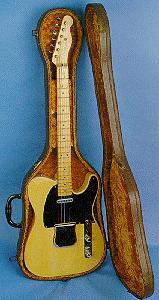
Telecaster, Broadcaster, NoCaster, Tele Custom, Tele Thinline, Rosewood Tele.
Collectibility Rating: 1950’s models: B+, 1960’s models: C+.
- The first Fender solidbody model, the
- , lasted (in name only) from June 1950 to October 1950. This model name was replaced by the “Broadcaster”, which lasted (in name only) from the October 1950 to January 1951. The majority of Broadcasters have body and neck dates of November 1950 and usually have a serial number of 0xxx or 00xx (the lastest Broadcaster serial number i have heard of was in the 08xx range and the earliest documented is serial number 0005), but 12/50 and 01/51 Broadcasters do exist. All Broadcasters have truss rods, where many 1950 Esquires often have no truss rod.
In 1937 Gretsch had trademarked the name “BroadKaster” for a line of drums. After advertising the Broadcaster in music trade papers in February 20, 1951, Gretsch took notice and sent Fender a telegram asking them to change their name. Therefore Fender was forced to drop the name Broadcaster. Starting around February 22, 1951, Fender cut the word “Broadcaster” off of their headstock decals. These models (February 1951 to summer 1951) are known as “NoCasters”. Starting in the summer of 1951, Fender adopted the name “Telecaster” for this model, and started using new decals after all the old clipped decals were used. Decal attachment was the last assembly step, so NoCasters with a February neck date are seen. Note that the above dates are accurate for the Esquire, Broadcaster and Nocaster.
All Telecasters basically have the same features: single cutaway slab body, 2 chrome knobs, 3 position toggle switch, 3 paired adjustable bridge saddles, strings anchor thru body (except in late 1958 to 1959).
Starting in 1959, Fender introduced a new model, the Telecaster Custom. It was the same as a standard Tele except it came in three color sunburst, and the body had a bound body.
1969 Fender Thinline with
Ash body and “old style”
Tele pickups.
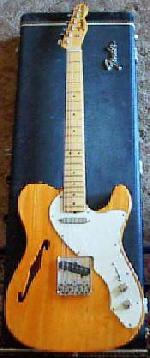
- In late 1968, Fender introduced the
Telecaster Thinline
- . Much like Gibson’s 335, the Thinline has a solid center with hollow “wings” and a single “F” hole. Apparently Fender’s supply of lightweight ash was drying up. Fender looked for ways to use readily available, but heavier grades of ash for the Telecaster. Their solution was to hollow out portions of the body to reduce weight. The body was routed from the back on each side of pickup assembly creating hollow “wings”. A thin back panel was then glued on the back. A new style pearloid pickguard was used too. When it was introduced in late 1968, the Telecaster Thinline was offered with either a natural finished ash or mahogany body. In 1969, a three tone sunburst finish was also offered as an option. Also in 1969 the maple cap fingerboard gave way to a one piece maple neck with the back “skunk stripe”. Finally in late-1971, the Telecaster Thinline was outfitted with a pair of Fender’s new humbucking pickups and it remained unchanged in the Fender line until it was discontinued in 1980.
1972 Tele Thinline. Note the “new style”
humbucking pickups.
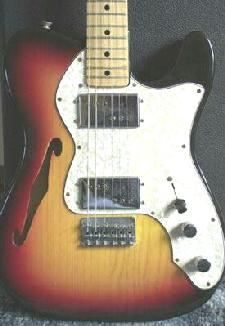
- Although there were several deviants of the original Tele Thinline, the only collectable model is the one with standard Tele-style single coil pickups. This variant was made from late 1968 to early 1971 and said “Fender Telecaster” only on the peghead (as per regular solidbody Telecasters), the truss rod adjusted at the butt-end of the neck, and had a pearloid pickguard going from the neck pickup to the tone control. The body was available in ash or mahogany. The mahogany body is much more desirable, but unfortunately fewer were made compared to ash. Also, a neck with a rosewood fingerboard is also more desirable. This is because there is less “thickskin” finish on a rosewood fingerboard neck, since the fingerboard is unfinished (thickskin maple necks are horrible to play; they feel like you’re playing a plastic neck – tt is rare, but there are some lacquer neck Thinlines out there). Also the tone of a rosewood fingerboard and a mahogany body is more “thick and creamy”, making the Thinline very unique for a Telecaster-style guitar. The most common finish on a Thinline is a clear “thickskin” finish, though other colors such as sunburst were available. Often the thickskin finish tries to delaminate on these guitars because the body is more flexible than a standard Telecaster body.
- In late-1971, Fender changed the Thinline model to use Humbucking pickups, a “bullet” truss rod (adjusts at peghead), and the peghead decal now says “Fender Telecaster Thinline”. These models are not collectible. The original Telecaster Thinline was reissued by Fender of Japan in the early 1990’s. These reissues are often confused with the original late 1968 to early 1971 Thinline models.
The Rosewood Telecaster, introduced in 1969, had a neck and body made from solid rosewood. This guitar was reissued by Fender of Japan in the late 1980’s and is a very close reproduction.
Telecaster Peghead Decals:
- Custom Telecaster, 1959 to 1968.
For more information on the Telecaster, check out YourOldGuitar.com as they an inexpensive video available about 1950 to 1969 Telecasters. This video is highly recommended if you are interested in seeing original vintage Fender Telecasters from the inside.
October 1950 Broadcaster specs:
- Ash body 1.75″ thick with Butterscotch Blond finish.
- Maple one piece neck, all with truss rods. Sometimes the truss rod plug behind the nut on the peghead face is maple instead of walnut.
- Peghead truss rod plug is more rounded.
- Neck backshape feel was a large rounded “D” style neck. The fingerboard had a 7.25″ fingerboard radius with small (.078″ wide) frets (though a 9″ radius Broadcaster has been documented).
- Round button string tree (1st month models don’t have one).
- Silver “spaghetti” peghead Fender decal with black trim.
- Flat pole pickup in treble position and two wire notches in the black pickup base.
- Lead pickup has a tin (or sometimes copper) baseplate used for ground.
- Pickup windings cover with white string (which often looks black from the wax pickup potting).
- Knurled chrome plated brass knobs with a semi-flat top.
- Chrome covered pickup in neck position.
- Black vulcanized fiber (often called “bakelite”) pickguard, clear coated with lacquer (though one white fiber pickguard Broadcaster is documented).
- Four digit serial number on bridge plate, starting with “00” or “0”.
- Round Dak-a-Ware switch tip.
- Two patent number 3-way switch CRL 1452 (2291516, 2291517).
- Stackpole pots (manufacturer number 304).
- Blend control pickup wiring (no tone control).
- Often the rear string ferrels are not aligned.
- Steel bridge saddles till November 1950, then brass with flat bottoms.
- Body date in neck pocket.
- All screws have slot heads (including the truss rod adjuster).
- Many Broadcasters bodies do not have the diagonal wire route between the neck pickup and the control cavity. This route was added to allow easier drilling and mounting of the neck pickup’s wire to the control cavity. Instead a long drill bit was used to drill a hole thru the truss rod adjustment channel in the neck pocket, thru the neck pickup route, down the center of the body, to the lead pickup.
- Many Broadcasters also have a “ground hole” in the pot control cavity. The theory is this hole is drilled from the bridge plate/pickup route to the pot control cavity, but was not used (since a separate ground wire is not needed for the bridge, due to the design of the bridge pickup mounting screws and bridge pickup ground plate, and how the guitar was wired to the bridge pickup). Other stories for this hole is it’s a “nail hole” (as used in 1959 and later Teles), or the hole comes from the screw-tip augar drill bit used to drill the side jack hole.
- Brown rectangle Cornell Dubilier paper tone capacitor and brown tube paper tone caps used.
- Kluson Deluxe tuners with “Kluson Deluxe” in a single vertical line (aka “single line”), no second hole on side of gear shell (for the tuner peg), “pat. pend” on side bottom side of gear shell.
- Milled chrome plated brass jack cup with ribbing on sides to hold jack inside the body hole – no other attachment method used.
- A guess is that about 200 Broadcasters were made, before changing to the “NoCaster”.
The unused Broadcaster hole in the pot control route (not seen on “NoCasters”).
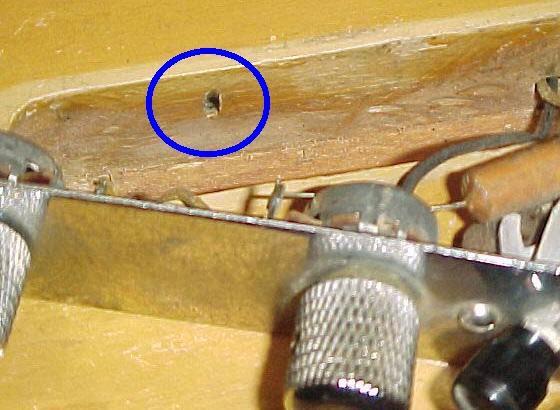
Blue Circle: Broadcaster neck pickup wiring hole, used on Broadcasters
without the diagonal wire route.
Red Circle: Broadcaster “nail hole” used for painting, filled with redish/white
rubbing compound.
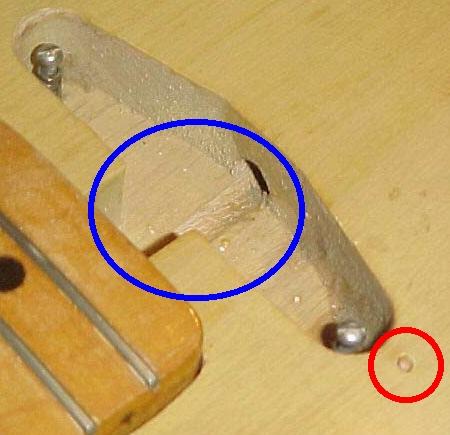
On Broadcastes without the diagnonal wire route, the continuation of the above
neck pickup wire hole, which goes to the bridge pickup.
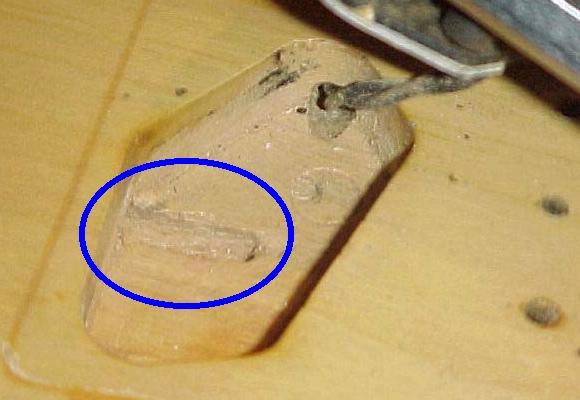
February 1951 “NoCaster” specs:
- Fender decal with “Broadcaster” cut off. Collectors call this a “NoCaster”. Decal is usually silver (cut silver Broadcaster decal), but there are a few NoCasters with gold decal (probably cut gold Esquire decals by mistake!)
- The diagonal route between the neck pickup and the pot cavity is always present. In addition, there is also sometimes a hole going from the neck pickup to the bridge pickup that was used on Broadcasters for the neck pickup wiring (which is not used on the Nocaster). Note some early NoCasters do not have the diagonal route.
- Kluson Deluxe tuners with NO “Kluson Deluxe” in a single vertical line (aka “no line”), no second hole on side of gear shell (for the tuner peg), NO “pat. appl” on side bottom side of gear shell (moved to underside of tuner base).
- Brass brige pickup grounding plate.
- Sometimes a “D” stamp is seen on either the neck or body neck pocket, or both until 1954.
- According to Smith, about 1100 Fender guitars were made during 1951 where 275 were single pickup Esquires, 100 Broadcasters, and about 475 Nocasters and 250 Telecasters.
Fall 1951 Telecaster specs:
- After all the cut “NoCaster” decals were used, “Telecaster” decals appear around 9/51. Still a silver “spaghetti” Fender logo with black trim.
- The placement of the Fender logo between spring 1951 and late 1951 is parallel to the neck end and not at an angle, as seen before and after last 1951.
- Kluson Deluxe tuners with NO “Kluson Deluxe” in a single vertical line (aka “no line”), ADDED second hole on side of gear shell (for the tuner peg).
- Truss rod adjustment screw changed from slot.
- The lead pickup no longer has the two notches in the black pickup base for the winding wires.
- Gradual use of phillips head screws replaces slot head screws (this change was not complete till 1953).
- Knurled chrome plated brass knobs with a round top.
- Late 1952: pressed jack cup replaced milled jack cup. An added internal metal plate is used inside the body jack hole to secure milled cup.
- Walnut peghead truss rod plug is more oval shaped.
- Late 1952: Wiring changes on Tele. Now instead of the last knob being a “blend” control (allowing both pickups to be used at the same time), it now becomes a tone knob. The 1950-1952 wiring used a .05mfd cap between the 3 way switch and the volume pot, and a 15k resistor coming off the 3 way switch.
1953 Telecaster specs:
- Neck fingerboard dots change spacing. On pre-1953 models, dots are about 1″ (center to center) apart at the 12th fret. On 1953 and later models, the dot spacing is about 1 1/8″ center to center.
- New wiring on a Telecaster. (Note the wiring change was late 1952.) That is, the 3 position switch forward position was the neck pickup with a “woof tone” capacitor (no tone adjustment.) Middle switch position was the neck pickup with the tone knob implemented. Rear switch position was the bridge pickup with no tone adjustment. This wiring used a .05mfd cap soldered between the two pots, and a .1mfd cap between the volume pot’s ground and the 3 way switch.
- Flat-side (“poodle”) guitar-shaped cases used during 1953.
- Serial number on neck plate.
- Blond body finish has a more whitish look than the earlier “butterscotch” finish. In reality, the body finish was probably applied no differently, but the type of clear lacquer used to clearcoat does not yellow as much This gives mid-1954 and later Teles a more whitish blond look, instead of butterscotch. Because of the more whitish look, a distinct “halo” can be seen around the edge of the body that is less translucent (this halo was present on the earlier butterscotch finishes, but it was far less noticable). The halo was used to hide the side grain of multi-piece bodies, because Fender could easily match the face grain, but it was difficult to match the side grain.
- White single layer ABS pickguard .060″ thick replaces black pickguard with dull backside.
- Bridge saddles change from 5/16″ brass to 1/4″ steel smooth saddles with rough finished ends. Also the angle of the string height screws changed to be about 45 degrees.
- Daka-Ware “Top Hat” style switch tip starts to be used instead of the round tip.
- “D” neck/body stamp is largely not seen after 1954 (except on an occassional neck up 1957).
- Case changes to a rectangle tweed case.
A transition Telecaster:
Tele with masking tape date 8/16/54 (“Elenor”) has serial
number on the bridge plate (#259x), no serial number on neck plate,
white pickguard, steel bridge saddles, and whitish blond finish.
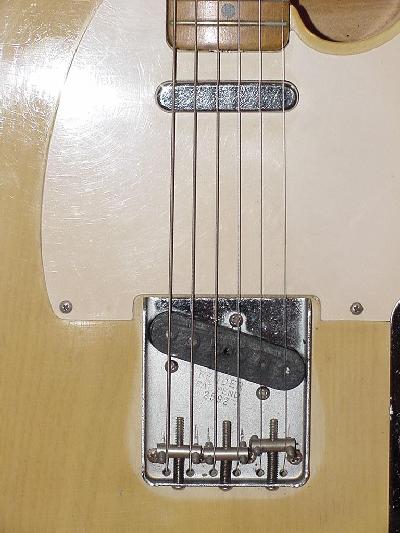
Mid 1955 Telecaster specs:
- Staggered pole pickup magnets replace the previous “flat pole” pickup in the treble position.
- Sunburst finish done on a small batch of Telecasters, and then discontinued.
- White pickguard now has a shiney backside.
- Body date moved from neck pocket to under lead pickup (late 1955).
- “Top Hat” style switch tip used exclusively.
- String tree changes from round button to “butterfly” clip.
- String tree moved closer to the nut, roughly in alignment with the A-string tuning
- “Single Line” Kluson Deluxe tuners (which says “Kluson Deluxe” in a vertical line).
- Peghead decal position changes to between the nut and the string tree (rather than next to the G-string tuning post).
- Peghead has much sharper edges. No longer is Fender sanding and rounding the edges of the peghead.
- Neck backshape gets a large “soft V” shape.
- Metal control knobs change from a chrome plated brass course knurl rounded top design, to a fine knurl flat top pot-metal knob.
- Most 1957 Teles have a neck with a “strong V” backshape.
- Sunburst finish done on a small batch of Telecasters, and then discontinued.
1958 Telecaster specs:
- Bridge saddles change from smooth to threaded saddles. Also the angle of the string height screws changed back to be about 90 degrees.
- Strings anchor at bridge (“top loading”) instead of going thru the body (late 1958). This changed the sound of the Telecaster (and not for the better!)
- Neck is a thinner “D” neck shape (the famous “V” neck is gone). As 1958 progresses, the neck backshape gets thinner.
- Slab Rosewood fingerboard.
- Neck now has a very thin “D” backshape. As 1959 progresses, the neck backshape gets thinner. By the end of 1959, the neck has an extremely thin backshape.
- Single layer thick white pickguard (though some custom color Teles used three layer celluloid mint green pickguard, as also used on the Custom Telecaster).
- Number of pickguard screws increases from five to eight.
- “Custom Telecaster” introduced with body binding, sunburst finish, and three layer celluloid mint green pickguard. The first few models have a peghead logo the same as a regular Telecaster. Then a gold spaghetti peghead decal reads “Custom Telecaster” (not Telecaster Custom!), with the model name lettering slightly bolder than a regular Telecaster. Earliest Custom Telecaster date I have seen is 4/59, but there are rumors of some early 1959 Custom Teles with a regular “Telecaster” (instead of “Telecaster Custom”) peghead decal.
- Brown paper rectangle tone cap changes to a white “chicklet” paper tone capacitor.
1960 Telecaster specs:
- Strings anchor thru the body again, but bridge is still drilled for top loading strings (this happened by late 1959).
- The blond finish seems to become less translucent, hiding more of the wood grain.
- Position of the body “nail holes” moved – around this time the nails were moved to inside the body routes, like inside the neck pocket or truss rod adjustment route, inside the bridge pickup route, and inside the wall of the control cavity route. Why this was done I am not exactly sure (it wasn’t done on the Strat). Also the fourth nail positioned on the cutaway was dropped.
1961 Telecaster specs:
- By 1961, neck backshape is a fatter “D” shape, but still not quite as fat as 1958 and prior Telecaster necks.
- White “chicklet” paper tone capacitor and tube paper tone cap change to red round disc capacitors.
- By late 1961, patent numbers 2,573,254 and 2,784,631 added to peghead decal, and DES number 164,227.
- About 8/62, veneer Rosewood fingerboard instead of the previous “slab” style.
- Neck screws change from being partially threaded, to being fully threaded their whole length.
Late 1962 Telecaster specs:
- Neck pocket no longer entirely painted. Instead a “paint stick” (a piece of wire conduit hammered flat) is used to hold the body during the painting process. This leaves a bare area on the bass side of the neck pocket with no paint.
- Last of the drilled top loading bridges used up.
1963 Telecaster specs:
- Telecasters were offered with a mahogany body and a translucent red finish. Not very many were produced, and this option is only seen in 1963/1964.
- 12th fret neck dot markers moved closer together.
- By late 1963, body dates were no longer used.
Fall 1964 Telecaster specs:
- Pearloid fingerboard dots replace “clay” dots (this transitioned into early 1965).
- Pickguard changed to a white plastic W/B/W three layer laminted plastic.
- The Custom Telecaster peghead decal changed to the gold “transition” style decal with patent numbers 2,573,254 and 2,784,631 and DES number 164,227.
- Pickup changes from “black bottom” to “gray bottom” (again this transitioned into 1965).
- Tuners change from “single line” Kluson Deluxe to “double line” Kluson Deluxe (where “Kluson” and “Deluxe” are now in two vertical parallel lines).
Late 1965 Telecaster specs:
- Gold Fender “transition” decal, thicker than previous “spaghetti” logo. Two patent numbers of 2,573,254 and 3,143,028 (the DES number is dropped).
- Glued-on Maple fingerboard available as an option (black dots), with no back skunk stripe.
1967 “Smugglers” Telecaster.
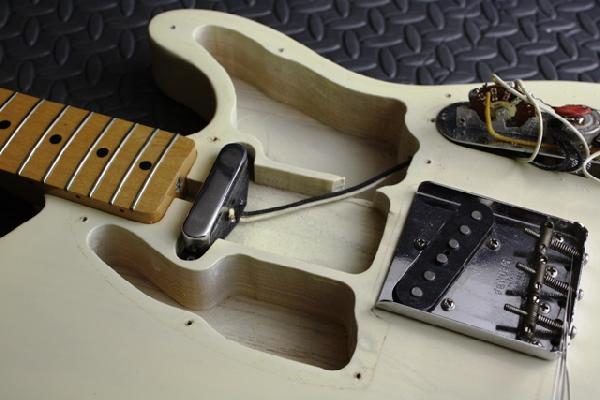
- Glued-on Maple fingerboard with no back skunk stripe “officially” available, even though in practice it was readily available in 1965 and 1966 (no skunk stripe).
Fall 1967 Telecaster specs:
- End of the Kluson tuners. In fall of 1967 tuners changed from Klusons to “F” tuners.
- End of gold “transition” Fender peghead logo. In fall of 1967 peghead logo changes to a larger black decal.
- End of 1953 to 1967 the wiring on a Telecaster. (Note the wiring change was late 1967.) Most 1967 Telecasters have the older wiring: the 3 position switch forward position was the neck pickup with a “woof tone” capacitor (no tone adjustment.) Middle switch position was the neck pickup with the tone knob implemented. Rear switch position was the bridge pickup with no tone adjustment. This wiring used a .05mfd cap soldered between the two pots, and a .1mfd cap between the volume pot’s ground and the 3 way switch.
- “Smugglers” Telecaster made in late 1967. Fender had a problem finding light weight ash for Tele bodies, and experimented with what is known as a “smugglers” Tele body with heavier ash. The body was routed somewhat like a Thinline Telecaster, with major wood areas removed underneath the pickguard. (Most people didn’t even know they had a smugglers Tele until they removed the pickguard.)
Telecaster wiring diagrams.
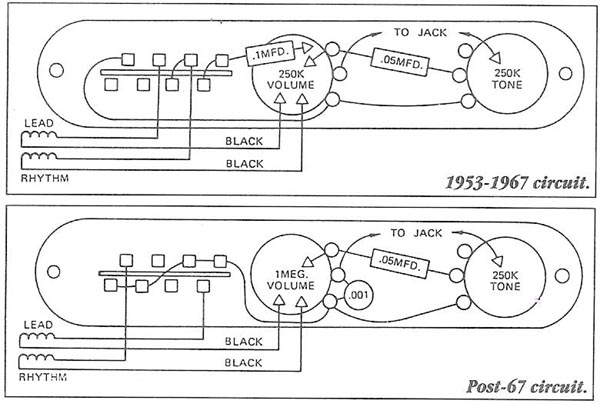
1968 Telecaster specs:
- 1968 marks the end of an era for the Telecaster. With the changes noted below, the “pre-CBS” era is over. (Even though CBS officially bought Fender in 1965, it took until the fall of 1967 for the changes to really make a difference.)
- Black Fender decal with gold trim with the two patent numbers moved under the “Fender” part of the decal. (Actually this style Fender logo started in the fall of 1967.)
- “F” style tuning gears replaces Kluson-Deluxe gears. (Again this style of tuners started in the fall of 1967.)
- Wiring changed (late 1967.) Now a more traditional 2 pickup selection was implemented. The front switch position was the front pickup, middle switch position was both pickups, and back switch postion was the bridge pickup. All three positions used the tone knob. To do this a .05mfd cap was put between the volume and tone pots, and a .001mfd cap between two lugs of the volume pot.
- 3 position switch changed. A new style 3 way switch was used.
- End of cloth covered wire. Now all wire is PVC plastic covered.
- Polyester “thick skin” finish replaces nitrocellulose lacquer. This transition is slow, and often a 1968 Tele can have a poly finished body with a lacquer neck.
- Fender black peghead decal is now under the finish, instead of on top. Because of this, the face only of the peghead stays lacquer, even though the rest of the neck is polyester (was done this way because the poly finish reacted with the decal). This can really be seen on well-used Teles, because the poly finish does not yellow, where the lacquer peghead finish does. Hence the face of the peghead can be a yellowish-brown, and the rest of the neck is not. Also the face of the peghead can finish-check, where the rest of the poly neck generally will not.
- String ferrules on back now stick out, no longer flush.
- Pink paisley and blue floral finishes available 1968 & 1969 only.
- Tele Thinline was introduced (late-1968).
- On Custom Telecasters the peghead decal changes to a regular Telecaster style decal (the “Custom Telecaster” designation is dropped).
1969 Telecaster specs:
- Maple necks went back to the “one piece” construction, with a shunk stripe (but some necks can be seen during this period with both a separate fingerboard and a skunk stripe).
- Rosewood necks now how a contrasting “skunk strip” on the back of the neck (Fender wanted to use just one truss rod construction system!)
- The diagonal body route between the neck pickup and the control cavity is suspended.
- The poly “thick skin” finish gets thicker.
- Still using one string tree on the peghead (two string trees started around 1971).
Still in production today in several different forms.
Back to the Table of Contents
1954-1959 style maple
fingerboard Strat

Stratocaster.
Collectibility Rating: 1950’s models: A, 1960’s models: A-.
- First introduced in spring 1954, it may well be the most popular and copied guitar design ever.
Asymmetrical double cutaway body, contoured body on back and on lower bass bout (where forearm rests), three single coil pickups with exposed poles, jack angled into top, tremolo standard (but available without a tremolo on special order), three knobs (volume, tone, tone), gold plated parts optional till 1967.
Stratocaster Peghead Decals:
For more detailed information on the inside details of the Fender Stratocaster, see the![]() Inside a 1954 to 1965 Fender Stratocaster video.
Inside a 1954 to 1965 Fender Stratocaster video.
March 1954 Fender Stratocaster introduction specs:
- First 100 Strats (or so) made have the serial number pressed into the back plastic tremolo plate. Serial numbers all four digits and starting with zero. The following several bullet points only applies to these models. The trem cover serial number models all have late May 1954 assembly dates and earlier.
- Introduced about late March 1954. Some 3/54 Strats have been seen and are prototype Strat bodies using three spring rear tremolos, instead of five springs; Also the route for the three springs was much narrowier (the “official” full production release of the Strat happened about October 1954).
- Extremely contoured ash body.
- Sunburst finish very crude. Infact, it’s a “one color” sunburst finish. The center part of the sunburst is natural ash with no yellow – Fender only sprayed the dark brown around the edges of the body to give the sunburst look. This type of sunburst only appears on early Strats with the serial number on the rear plastic tremolo cover.
- Volume and tone pots 100k ohms, solid brass shaft pots, usually made by Stackpole (code 304).
- Plastic white pickup covers and “mini-skirt” knobs have a marbelized translucent look.
May/June 1954 Fender Stratocaster specs:
- Extremely contoured ash body, two-color (“Canary yellow” to “Amber brown”) sunburst finish with the center yellow color sprayed (custom colors Strats were also made in 1954).
- Thin “spaghetti” peghead decal logo, no patent numbers.
- “Small” peghead, round string tree, truss rod adjusts at butt.
- Neck attaches with 4 bolts and a metal neckplate.
- 4-digit serial number on metal neck plate starting with “0100”.
- Rear tremolo back plate (white single layer .060″ plastic) has round string holes.
- Volume and tone pots changed to 250k ohms. This seemed to happen sometime in June 1954. Still solid brass shaft pots, usually made by Stackpole (code 304).
- Often a piece of masking tape is seen in the control cavity with the final assembly person’s signature. Most often seem is “Mary” as in Mary Lemus, a Fender factory employee (Mary began work at Fender in 1954 as an assembler, eventually becoming a final assembly supervisor). Also seen very often is “Gloria” as in Gloria Fuentes, another Fender factory employee assembler.
- Neck is one piece of maple with black dot position markers. Walnut “skunk stripe” down back of neck where truss rod was installed.
- Single layer, white ABS .060″ thick pickguard with 8 attachment screws (ABS was a new material in the 1950s). Back of the pickguard is matte finished until about 10/54, when the back of the pickguard changes to a gloss finish.
- A small aluminum sheilding plate is installed underneath the pickguard that covers the control cavity.
- White “bakelite” plastic knobs and pickup covers. These knobs are actually not Bakelite but are Polystyrene thermoplastic (think those plastic model kits you assembled as a kid with the smelly glue). First generation: early 4/54 to 7/54 Stratocasters have different knobs and pickup covers. These are marbelized and a bit translucent. This is seen mostly on the thinner plastic pickup covers than on the knobs, and the amount of translucency varies from guitar to guitar. Some pickups covers are so translucent the black pickup bobbins can be seen through the covers. Also the pickup covers had rounded edges even when they were brand new. The volume/tone knobs are a different shape too, known as “tallboys” or “mini-skirts”, being slightly taller and slimmer with the numbered skit being a much smaller variant of the famous 9/54 and later plastic Stratocaster knob. There were no “spokes” on the underside of these volume/tone knobs. The mini skirt bakelite knobs were mounted on smooth solid shaft potentiometers too (the 9/54 and later conventional Strat knobs were mounted on knurled split shaft pots). The shape of the 3-way switch tip resembled a symmetric “football”.
- Pickups have two very small “tits” in the bottom black fiber part of the pickup on the outside edge around the two wire eyelets. Also there is a very faint ring pressed into the black fiber that goes around each eyelet.
- White “bakelite” plastic knobs/covers, second generation (7/54 and 8/54 only): all Strat plastic parts used the same molds as the “first generation” plastic parts, but the plastic itself is different. Now the plastic is completely opaque, with no translucent or marbeling effect (the prior translucent effect is seen mostly on the pickup covers). Also the plastic is very white and stays very white (it does not yellow much with age, unlike the 1957 and later “vinyl” (actually ABS) plastic part – note the first generation Strat plastics don’t really yellow much either.)
- White “bakelite” (actually Polystyrene) plastic knobs/covers, third generation (9/54 to spring 1957): The plastic used on these “bakelite” knobs is the same as the second generation, but a new mold and knob shape was used. The new molds included the volume/tone knobs, 3-way switch tip, and the pickup covers (the tremolo tip didn’t seem to change shape). Because the earlier mini-skirt volume/tone knobs had problem with the skirt breaking (because it was so petite and thin), Fender changed the knobs to the now-famous standard Stratocaster knob shape. The skirt was larger, and had three “spokes” on the under-side of the skirt to provide support. These knobs too cracked easily, but in general they did not self-destruct like the mini-skirt versions. Also the pots used with the third generation bakelite volume/tone knobs had a split shaft instead of a solid shaft. And the pickup covers were changed slightly to sharp edges (to increase strength, but often the sharp edges would round due to player wear). Also the switch tip “football” changed to a pear shape.
- The tremolo tip basically stayed the same shape for all three generations of Stratocaster plastic. The only noticible difference is the slight translucent plastic look the tremolo tip had from 4/54 to 7/54 during the first generation plastic parts era.
- Tremolo metal bar has strong exagerated bends.
- Steel 2 piece tremolo, with 6 adjustable saddles. Each nickel plated saddle is stamped “Fender Pat Pend” (note reissue models are stamped “Fender Fender”). The “Fender Pat Pend” is very faint (until about 1962). Also the front edge of the saddle (closes to the nut) is shorter in 1954. The Strat was available without tremolo (known as a “hardtail” model) by special order only (and in this case, a special order non-trem Strat is worth way less than the much more common “trem” model).
- Tremolo block’s string-end ball holes are more shallow. These holes were deepened around fall 1954 to accomodate larger string-end balls. Also the side edges of the tremolo block were very rounded. This changed in 1955 to be less rounded.
- Neck backshape feel was a large rounded “D” style neck. The fingerboard had a 7.25″ fingerboard radius with small (.078″ wide) frets.
- Edges of the peghead rounded. This stoped by 1955 with the peghead edges becoming much sharper at the edges.
- Sometimes the under-the-pickguard route for the lead pickup does not have the wire channel route until about summer 1954, when Fender added a shallow wire channel route in the lead pickup cavity. Because this proved to be a problem, often a hand chiseled wire channel was added to the Strat body by the final assembly person. This is easy to identify as there is no paint in this crudely hand chiseled wire channel in the bottom of the lead pickup route. This is most often seen in mid to late 1954 Strat bodies. Also the 1954 bridge pickup wire route is not as deep as on 1955/56 and later models, so sometimes this route is crudely deepened with a hand chisel during final assembly.
- 3-way CRL switch has three patent numbers. The bakelite plate that holds the switch contacts has angled sides.
- “No Line” Kluson Deluxe tuners (which do not say “Kluson Deluxe).
- “Bobby Lee” style strap included with the guitar. The padded portion of the strap is rectangle. 1955 and later Strat straps have the padded portion banana-shaped. Pre-CBS black Strat straps do not have a “Fender” logo on the strap buckle.
October 1954 Fender Stratocaster specs:
- Now the strat is considered to be “production” and it’s characteristics are gelled and more consistent. Guitar is now an assembly-line produced instrument and has less “hand made” inconsistencies. Forrest White insisted that any Stratocasters produced before October 13, 1954 were “pre-production samples” or “artist models” (and were probably all sold directly to musicians from the Fender factory instead of through Fender Sales). The reason for this was purchase order PO #242 from Fender Sales for 100 Strats, which was finished and delivered on October 13, 1954. After this point Fender Sales (a different company than Fender Musical Instruments) handled all sales of Stratocasters, and technically no units were available directly from the factory. Models available before October 1954 were often “demonstrators” brought to music store to be shown off, and sometimes sold.
- Pots are split shaft 250k ohms, usually made by Stackpole (code 304).
- Channel route or wiring in lead pickup cavity is usually more “factory” looking and has finish over the route (but even late 1954 Strats can still have the lead pickup wiring “worm route” done during final assembly, showing bare wood with no finish).
1955 Fender Stratocaster specs:
- Peghead edges are less rounded, and more sharp.
- By mid-1955, the round string holes in the rear tremolo cover are changed to oblong holes.
- Tremolo block has more squared sides.
- Front edge of bridge saddles (closest to the nut) are longer.
- Bobby Lee strap pad is banana shaped.
- Tremolo bar’s bends are less pronounced.
A 9/56 non-tremolo blond Stratocaster that was sent back to the factory for modification. The guitar was converted from non-tremolo to a tremolo, and factory refinished. This is easy to see because the original ground hole for the non-tremolo bridge wire is still present (blue circle). Also the peghead “Fender” decal will be missing the “with synchronized tremolo” statement below the word “Stratocaster”, even though the guitar now has a tremolo. Also note the lack of a “shoulder” in the pot/switch route near the hand drawn white arrow (the shoulder was added in mid-1959 when fender added more screws to the pickguard).
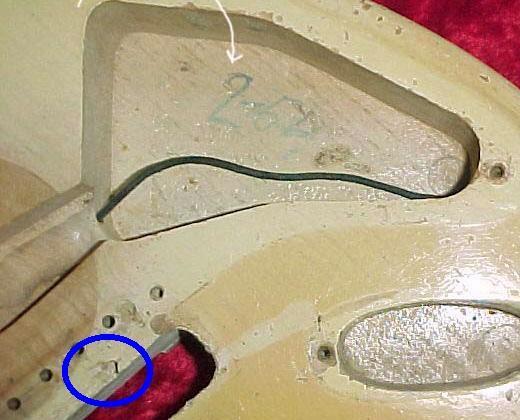
Mid 1956 Fender Stratocaster specs:
- Alder body replaces Ash on sunburst finished Strats (blond Strats still use Ash). Also the body finishing procedure changes because of the change to alder – Now the yellow in the sunburst is dyed into the wood, instead of being sprayed (as was done on Ash body sunburst Strats).
- Rectangle string tree (“butterfly”) replaces round string tree.
- Neck backshape gets a large “soft V” shape.
- “Single Line” Kluson Deluxe tuners (which says “Kluson Deluxe” in a vertical line).
- Tremolo bar has an even less pronounced bend.
- Pickups no longer have the two very small “tits” in the bottom black fiber part of the pickup on the outside edge around the two wire eyelets. Also gone is the very faint ring pressed into the black fiber that goes around each eyelet.
Spring 1957 Fender Stratocaster specs:
- ABS plastic knobs and pickup covers replace “bakelite” (Polystyrene) Many spring 1957 Strats have a mix of Bakelite and ABS parts, with ABS pickup covers yet bakelit knobs – this happened because the bakelite pickup covers ran out of stock first, so for a month or two of production some 1957 Strats can have ABS pickup covers and bakelite knobs).
- Most 1957 Strats have a neck with a “strong V” backshape.
1958 Fender Stratocaster specs:
- Sunburst finish changed to three colors (red added), going yellow to red to dark brown.
- Neck is a thinner “D” neck shape (the famous “V” neck is gone). As 1958 progresses, the neck backshape gets thinner.
1959-1964 style rosewood
fingerboard Strat

Mid 1959 Fender Statocaster specs:
- Starting May 1959 “slab” Rosewood fingerboard with white “clay” position dots and 7.25″ finger board radius. Bottom of fingerboard (part glued to maple) is flat. This change was implemented for the summer 1959 NAMM show. Basically Strats 5/59 and later will have rosewood fingerboards.
- Celluloid “mint green” three layer (white/black/white) pickguard (sometimes called a “nitro” pickguard), with 11 attachment screws. This celluloid pickguard was implemented around 7/59. So for a short time rosewood fingerboard Strats were made with a single layer white pickguard with 11 screws. Some 7/59 Strats even had a single layer white pickguard with 8 or 9 or 10 screws (though this is rare). Also in the same time period some 1959 Strats were made with a maple neck and a 8 screw three layer celluloid pickguard (this implies the body will not have a “shoulder” under the pickguard in the control cavity).
- A thin aluminum sheild the size of the pickguard is installed underneath the three layer pickguard. This replaces the thicker and much smaller shield previously used on single layer pickguards (this older style shield encompassed just the three pots and the switch).
- Stratocaster body now has a “shoulder” in the potentiometer control cavity. This “bump” in the cavity was implemented to allow the use of another pickguard screw by the 3-way switch. This shoulder can only be seen with the pickguard removed. All rosewood fingerboard Strat bodies with 11 pickguard screws should have this shoulder.
- Fender used a very photo-reactive red dye in their sunburst finish, causing many 1959 Strats to fade from a 3-color sunburst to a 2-colors (the photo-reactive nature of the red caused fading from ultra-violet light). This is typically seen on the front of the body, where the back often still has the red in the sunburst. If the pickguard is lifted, the original red finish in the sunburst can still be seen.
- Neck now has a very thin “D” backshape. As 1959 progresses, the neck backshape gets even thinner. By the end of 1959, the neck has an extremely thin backshape. Also most mid to late year 1959 Strats will usually not have a neck date below the truss rod adjustment.
- Brown paper rectangle tone cap changes to white “chicklet” paper tone capacitor.
- A metal spacer was added below the butterfly string tree.
7/59 rosewood fingerboard Strat with single layer white pickguard.
Note the red has faded from the sunburst finish.
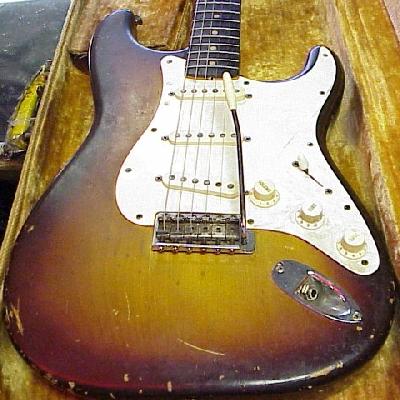
A 1959 Strat with a maple neck and an 8 screw three layer celluloid pickguard.
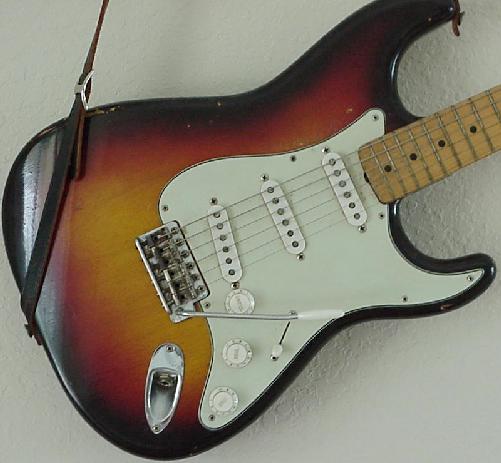
1961 Fender Stratocaster specs:
- Peghead decal logo now has 2 patent numbers (2,573,254 & 2,741,146: 2573254 is for strings though the body as used on a hardtail, 2741146 is for the tremolo).
- Neck backshape is a fatter “D” shape, but still not nearly as fat as 1958 and prior Stratocaster necks.
- Fender now using a more robust red in their sunburst finish. Hence 1961 and later Strats don’t have sunburst finished with a faded out red.
- The dark “Amber brown” part of the sunburst finish is now changed to “black”. Hence the dark part of the sunburst is more striking and does not blend as well as prior sunburst finishes. It is a subtle change.
- White “chicklet” paper tone capacitor changes to a red round disc capacitor with yellow insulting tubing on one leg of the cap.
1962 Fender Stratocaster specs:
- Peghead decal logo now has 3 patent numbers (2,960,900 added, which is the patent for the contour body)
- March 1962 is the last month for a “penciled” neck date on the butt of the neck (only seen if neck removed). After March 1962, the neck date is now stamped with a rubber stamp, starting with the number “2” (to signify a Stratocaster neck). For example, “2APR62B” (where the “B” signifies a 1 5/8″ nut width).
- Body dates are becoming less common.
- The 3-way CRL switch still has angled sides, but the bakelite material that holds the switch contacts is lighter and less fiberous in color.
- Neck screws change from being partially threaded, to being fully threaded their whole length. This applies to the tremolo claw screws too.
Mid 1962 Fender Stratocaster specs:
- Veneer Rosewood fingerboard. Bottom of fingerboard (part glued to maple) is arched. Happens 8/62, around serial number 81000.
Late 1962 Fender Stratocaster specs:
- Neck pocket no longer entirely painted. Instead a “paint stick” (a piece of wire conduit hammered flat) is used to hold the body during the painting process. This leaves a bare area on the bass side of the neck pocket with no paint.
Early 1963 Fender Stratocaster specs:
- Location of the pickguard screw between the neck and middle pickup is moved about 1/2″ towards the middle pickup.
- Bridge saddles’ “Fender Pat.Pend” stamping is more pronounced.
- Contouring of the body is slightly less dramatic.
- By late 1963, body dates were no longer used.
- By late 1963 the 3-way CRL switch changes to the “half moon” shape instead of having the angled sides.
Mid 1964 Fender Stratocaster specs:
- A gold Fender peghead decal thicker than previous “spaghetti” logo. This is known as the “transition” Strat logo. Now has 4 patent numbers (3,143,028 added).
- The finish on the sunburst changes (especially the yellow, which is now sprayed in addition to the yellow body dye, and is far less translucent). See the Fender Colors article for more details. Sunburst finish has a more “target” look with a more dramatic change of the three colors, with less blending between colors.
Late 1964 Fender Stratocaster specs:
- About 12/64 the “nail holes” are no longer present under the pickguard.
- Pearloid fingerboard dots replace “clay” dots. This transitions in with the 1/4″ fingerboard dots converting to pearl first, followed by the smaller side dots becoming pearloid.
- Plastic white three layer pickguard replaces the “mint green” celluloid (this happens about 12/64 to 3/65, though early style mint green celluloid pickguards can be found on some Strats throughout 1965).
- Tuners change from “single line” Kluson Deluxe to “double line” Kluson Deluxe (where “Kluson” and “Deluxe” are now in two vertical parallel lines).
- Contouring of the body is even less dramatic, especially at the right forearm.
- Pickups change from “black bottom” to “gray bottoms”. Dates are often seen on the bottom of the gray pickups in either a black hand-written pen, or in a yellow ink stamp.
- The metal spacer below the butterfly string tree was replaced with a white plastic spacer.
Late 1965 Fender Stratocaster specs:
- Peghead design enlarged significantly about 12/65 (known as the “large peghead” Strat).
- Maple fingerboard optional (2 piece neck, no “skunk stripe”).
- Peghead Fender decal has 5 patent numbers (2,573,254 & 2,960,900 & 2,741,146 & 3,143,028 & 2,817,261).
- Often the “film” of the peghead “Fender Stratocaster” decal is much larger. This large film decal only lasted a month or two, around 12/65. (But I have also seen this large film decal used in 1966.)
- After serial number L99999, the serial number plate now has a large script “F” (known as a “F plate”). The serial number starts at 100000 but with no preceeding “L”.
1966 Fender Stratocaster specs:
- Peghead Fender decal has 5 patent numbers (2,573,254 & 2,960,900 & 2,741,146 & 3,143,028 & 2,817,261).
- Cloth wires often yellow instead of white, and sometimes dark blue instead of black.
- “Worm route” in treble pickup cavity often not as shallow and more flat in shape than seen in 1965 and earlier Strats.
- Neck date number code for Stratocaster changes from “2” to “13”. For example, Instead of “2MAY65B” as used in 1965, the neck date would be “13MAY66B” (the number before the month is *not* the day but is the code for “Stratocaster neck” used by Fender).
1968 Stratocaster specs:
- Black Fender peghead decal with 2 patent numbers (2,741,146 & 3,143,028).
- “F” style tuning gears replaces “Kluson-Deluxe” gears.
- Polyester thick finish replaces nitrocellulose lacquer. This transition is slow, and often a 1968 Strat can have a poly finished body with a lacquer neck.
- Fender peghead decal is now under the finish, instead of on top. Because of this, the face only of the peghead stays lacquer, even though the rest of the neck is polyester (was done this way because the poly finish reacted with the decal). This can really be seen on well-used Strats, because the poly finish does not yellow, where the lacquer peghead finish does. Hence the face of the peghead can be a yellowish-brown, and the rest of the neck is not. Also the face of the peghead can finish-check, where the rest of the poly neck generally will not.
- Under the pickguard wiring transitions from cloth-covered wire to plastic (PVC) covered wiring. Tone capacitor changes from .1 mfd to .047 mfd.
1969 Fender Stratocaster specs:
- The one piece maple neck is back with a skunk strip.
1970 Fender Stratocaster specs:
- Peghead decal has 1 patent number (2,741,146).
Late 1971 Fender Stratocaster specs:
- 3 bolt neck with micro-tilt replaces 4 bolt system.
- Die-cast 1 piece chrome Mazac tremolo replaces 2 piece steel unit. Bridge saddles are now cast with no stampings.
- “Bullet” truss rod adjusts at peghead instead of butt-end of neck.
- Contouring of the body is even less dramatic.
- The under the pickguard routes for the pickups now have squared ends.
- The poly body and neck finish seems to get thicker, with a greater film thickness.
Late 1972 Fender Stratocaster specs:
- Second string tree added on peghead to hold G and D strings.
1973 Fender Stratocaster specs:
- The “Mocha Brown” color is introduced on the Fender Stratocaster (perhaps Fender’s most aesthetically challenged custom color!) A factory black pickguard was used for the first time on a Strat, but only on this color.
Mid 1974 Fender Stratocaster specs:
- Flush pole pickups replace staggered pole pickups.
1975 Fender Stratocaster specs:
- Black 3 layer pickguard, black knobs and black pickup covers (as used previously only on the Mocha Brown Strats). This color change transitions slowly. That is, black pickguards with white knobs and covers are seen first, followed by black pickguards and black knobs and covers.
1976 Fender Stratocaster specs:
- Serial number moves to peghead decal.
1979 Fender Stratocaster specs:
- Last year for the “large” peghead. Starting in 1980, Fender switches back to the (more attactive) small pre-CBS peghead style on most models.
Fender Stratocaster still available today in many forms.
Back to the Table of Contents
The Fender Precision Bass.
Collectibility Rating: 1952-1957: C-, 1957-1959: B, 1959-1965: C.
- First introduced in November 1951 as the first electric bass, the Precision Bass is the most popular bass design ever.
1951-1953 style Precision Bass (J. Pedan)
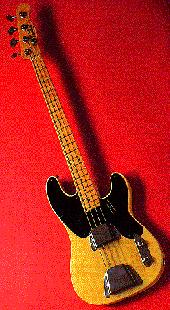
Precision Bass Peghead Decals:
- Precision Bass, 1951 to 1968.
1951 Pbass specs:
- Slab asymmetrical double cutaway ash body, blond finish.
- Black flat pole single coil pickup.
- Serial number on bridge plate.
- Black fiber pickquard clear coated with lacquer.
- One piece maple 34″ scale neck.
1954 Pbass specs:
- Contoured ash body (like Strat), two-color sunburst finish.
- White single layer ABS pickguard.
- Black staggered pole single coil pickup.
- Serial number on neck plate.
Mid 1957 Pbass specs:
- Split double-rectangular pickup replaces single coil.
- Anodized aluminum pickguard.
- Wider peghead design like a Strat replaces the Tele-style peghead.
- Three-color sunburst finish (in 1958).
- Slab Rosewood fingerboard.
- Tortoise grain celluloid three layer pickguard.
- Mid 1959 Pbass specs:
Mid 1962 Pbass specs:
- Veneer Rosewood fingerboard.
Late 1964 Pbass specs:
- Silver Fender decal thicker than previous “spaghetti” logo.
- Pearl fingerboard dots replace “clay” dots.
- Tortoise plastic three layer pickguard replaces celluloid.
1968 Pbass specs:
- Black Fender decal.
- “F” style tuning gears replaces backward-tuning “no-name” Kluson gears.
- Polyester thick finish replaces nitrocellulose lacquer.
1970 Pbass specs:
- Slightly narrow neck width.
- Maple or rosewood fingerboard available.
- Fretless option available.
Precision Bass is still available today in several forms.
Back to the Table of Contents
The Fender Jazz Bass.
Collectibility Rating: 1960-1962: B+, 1962-1965: B-.
- First introduced in 1960, this model had a narrow nut (1.5″) compared to the Precision Bass. The most valuable models are the first two years with concentric (stacked) volume and tone knobs and felt tipped string mutes. Leo Fender felt that they gave a more accurate acoustic string bass sound, which the jazz bass player ould prefer. The pickups were designed with two pole pieces per string. This produced a mellower tone and a less percussionized signal that was more forgiving on the less-than-efficient bass speakers of the 1950s and 1960s.
Jazz Bass Peghead Decals:
- Jazz Bass, 1962 to 1967.
1966 Jazzbass in original
black with matching black
peghead.

- Offset waist body, 2 pickups, 34″ scale, tapered fingerboard narrower at nut than Precision bass.
1960 Jbass specs:
- Contoured Alder body with three color sunburst finish.
- Slab Rosewood fingerboard.
- Concentric (stack) volume and tone knobs.
- Individual string mutes.
- Tortoise grain celluloid three layer pickguard.
1961 Jbass specs:
- Three knob electronics replaces concentric knobs, August 1961.
1962 Jbass specs:
- Veneer Rosewood fingerboard by August 1962.
- Mutes removed by mid 1963.
- 1963 Jbass specs:
1964 Jbass specs:
- Pearl fingerboard dots replace “clay” dots, late 1964.
- Tortoise plastic three layer pickguard replaces celluloid, late 1964. Note the tortoise part of the pickguard is still celluloid, but the underlying 3 W/B/W layers are no longer celluloid. This is easy to tell; the black layer is MUCH thinner, which can be seen on the beveled pickguard edge.
1965 Jbass specs:
- Binding added to fingerboard in mid to late 1965.
- White pearl block inlays replaces dots in mid 1966.
- Forward turning Kluson tuners started in mid to late 1966. Tuner button shape changes to oval shaped buttons.
- 1966 Jbass specs:
1968 Jbass specs:
- Black Fender decal.
- “F” style tuning gears replaces “no-name” Kluson gears. Tuner buttons are now “club” shaped.
- Polyester thick finish replaces nitrocellulose lacquer.
1971 Jbass specs:
- Maple fingerboard with black block markers becomes standard.
Late 1973 Jbass specs:
- 3 bolt neck with micro-tilt replaces 4 bolt system.
1974 Jbass specs:
- Black/white/black pickguard replaces tortoise on Sunburst models.
Jazz Bass is still available today in several forms.
Back to the Table of Contents
The Fender Bass VI.
Collectibility Rating: 1961-1963: C+, 1963-1965: C-.
- 6 string, 3 Strat-like pickups with metal frames, master volume and tone knobs, 6 adjustable bridge saddles, removeable bridge cover, Jazzmaster type floating tremolo, 30″ scale, rosewood fingerboard.
Bass VI Peghead Decals:
- Bass 6, 1961 to 1968.
Late 1961 Bass VI introduction specs:
- Slab rosewood fingerboard.
- 3 on/off switches for each pickup.
1963 Bass VI specs:
- Veneer rosewood fingerboard.
- Foam rubber mutes.
- 4th condenser switch added.
Late 1964 specs:
- Plastic pickguard replaces celluloid.
Late 1965 Bass VI specs:
- Bound fingerboard.
Mid 1966 Bass VI specs:
- Block fingerboard inlays.
1968 Bass VI specs:
- Black peghead logo replaces gold logo.
- Polyester finishes replaces nitrocellulose finish.
1975 Bass VI Discontinued. Re-introduced Japanese 1962 reissue in 1995.
Back to the Table of Contents
1958-1959 style Electric Mandolin

Electric Mandolin (AKA Fender Mandocaster)
Collectibility Rating: 1956-1959: D+, 1959-1965: D-.
- First introduced in spring 1956, the Electric Mandolin looks like a miniture Stratocaster. This is were it derives its value. As an instrument, it has limited usability because it has only four strings instead of the usual eight for a mandolin. Oblong pickup with reddish brown cover, no visible poles, “Fender” decal with no other markings.
- Contoured ash body, two-color sunburst or blond finish.
- Anodized aluminum pickguard.
- Serial number on neck plate (numbers do not follow standard Fender conventions).
- One piece maple neck.
- 1956 Electric Mandolin specs:
1958 Electric Mandolin specs:
- Contoured alder body replaces ash.
- Three color sunburst finish (red added).
Mid 1959 Electric Mandolin specs:
- Slab Rosewood fingerboard.
- Celluloid tortoise three layer pickguard.
- “Original Contour Body” decal added to peghead.
1965 Electric Mandolin specs:
- Gold Fender decal thicker than previous “spaghetti” logo.
- Plastic tortoise three layer pickguard replaces celluloid.
1970 Electric Mandolin specs:
- No “Original Contour Body” decal on peghead.
1972 Electric Mandolin specs:
- Sunburst finish only.
1974 Electric Mandolin specs:
- Black 3 ply pickguard replaces white.
1976 Electric Mandolin (Fender Mandocaster) discontinued.
Back to the Table of Contents
The Fender Duosonic and MusicMaster.
Collectibility Rating: 1956-1959 DuoSonic: D-, 1959-1965 DuoSonic: D–. The single pickup MusicMaster is considered a “F” for all years.
1959 DuoSonic.

- First introduced in mid 1956, the original Duosonic (two pickups) and the Musicmaster (one pickup) were Fender’s 3/4 size, student model, 22.5″ short scale beginners guitars. Master tone, master volume, 3-way pickup selector (switch on Duosonic only; with the switch in the middle position, the two pickups are in series, giving a humbucking pickup type sound). Hence their value is low compared to other models. These short scale student models were made to the same high quality standards and materials that Fender used for its more expensive models. For this reason, pre-1964 Musicmasters and Duo-Sonics are very well made.
In late 1964 both models moved to second generation, coinciding with the introduction of the Mustang. The “II” designation was then added to the DuoSonic and MusicMaster names. These models are more like the Mustang (except the Mustang has a vibrato), than the original DuoSonic/MusicMaster models. The differences in the new generation were in the body shape, pickguard, and electronics. It was available with either a 22.5″ or 24″ scale, but is most often found with the longer scale. The 24″ scale Duo-Sonic II, Musicmaster II, and Mustang of the September 1965 to October 1966 period are sometimes found with a slab rosewood fingerboard, usually of Indian rosewood (click here for a picture of this). Some Fender experts speculate that the slab board necks were leftovers from 1962 Jaguars. This is not correct as the dot spacing, peghead shape, and type of rosewood on a 1962 jaguar neck is different than these 9/65 to 10/66 necks. Mostly likely, since Fender was backordered on these guitars, slab boards were used because the manufacturing process was quicker for this style of fingerboard (a veneer fingerboard requires another manufacturing step).
- Slab 3/4 size body, Desert Sand brown finish. Early 1956 models had an Ash body, later 1956 models had an Alder body.
- Anodized aluminum pickguard (Duosonic has two pickups, Musicmaster has one pickup).
- Serial number on neck plate.
- One piece maple 22.5″ short-scale neck, 1 5/8″ nut width.
- 1956 Duosonic/Musicmaster specs:
1959 Duosonic/Musicmaster specs:
- Sunburst finish offered. This sunburst if often called “maroonburst” since it is an opaque finish with a yellow or peach center, and maroonish edges. Sometimes this sunburst was painted over the Desert Sand color.
- Slab Rosewood fingerboard.
- Single layer thick white pickguard.
- Desert Sand color dropped; only available in sunburst.
- 1.5″ nut width.
- Mid-1961 Duosonic/Musicmaster specs:
1963 Duosonic/Musicmaster specs:
- Sunburst finish dropped, white finish now standard. During late summer/fall of 1963 brown plastic pickguards are seen on these models with white body finish.
Late 1964 Duosonic II/Musicmaster II specs:
- Scale length increased to 24″.
- “II” added after model name to designate increased scale length.
- Body restyled like Mustang with offset waist.
- 3 ply plastic pickguard.
- Colors available were red, white and blue.
1969 DuoSonic discontinued.
1969 Musicmaster: both 22 1/2″ and 24″ scale models designated “Musicmaster”
1982 Musicmaster discontinued.
Back to the Table of Contents
The Fender Mustang.
Collectibility Rating: D- (due to it’s short scale and student model designation).
1969 “Competition” Mustang
with white “racing strip”

- The Fender Mustang was introduced in August 1964 before the sale of Fender Electric Instruments to CBS. The idea was to create a mid-line model between the student grade DuoSonic, and the professional Telecaster. The Mustang was a very popular model, and was made until 1981. Originally designed with a 22.5″ inch scale guitar, the Mustang is almost always found with a 24 inch scale. Early models had a slab alder body, but it was given the patented Fender contour body in early 1969.
The Mustang had two pickups and (usually) a 24″ short scale length. Though the scale length is longer than the original Duosonics/Musicmasters (which had 22.5″ scales), the Mustang is still considered a “student model”. Hence their value is low compared to other models. Originally the Mustang was introduced to replace the entire DuoSonic/MusicMaster line, becoming the new Fender student model. But The introduction of the Mustang moved the DuoSonic/MusicMaster lines to a second generation, 24″ scale length. Due to extreme backorders, all student-line Fenders stayed intact to 1969 when demand dropped and the DuoSonic was discontinued.
August 1964 Mustang specs:
- Slab body, red or white or blue finish.
- Gold “transitional” peghead logo.
- 2 slant mounted pickups with plastic covers and no visible poles.
- 2 on/off switches.
- Master volume and tone.
- Tremolo.
1968 Mustang specs:
- Black Fender decal.
- “F” style tuning gears replaces Kluson gears.
- Polyester thick finish replaces nitrocellulose lacquer.
- Red, blue, burgundy or orange finish with a white racing stripe.
- Contour body.
- 1969 “Competition” Mustang specs:
Mustang discontinued 1982.
Back to the Table of Contents
The Fender Jazzmaster.
Collectibility Rating: 1958-1959: C, 1959-1965: C-.
- Introduced in mid 1958, this model was Fender’s attempt to enter the jazz market. Leo Fender designed the pickups to produce a mellower tone than the Stratocaster and Telecaster. This was done to get jazz guitarists to use the model. However, very few jazz players liked it. Much to Fender’s suprise, it turned into the best surf guitar ever conceived. Leo Fender designed an all-new vibrato system and electronics circuit for the Jazzmaster. In addition, the Jazzmaster was the first Fender to be sold with a rosewood fingerboard.
Contoured body with offset waist, 2 rectangle white covered pickups, Gibson-like 3 way selector switch, volume and tone roller knobs on bass side, 2 master volume and tone knobs on treble side, floating tremolo and bridge (individual saddles), Strat-like peghead shape.
1965 JazzMaster with thicker
“transition” Fender decal
and new style knobs.
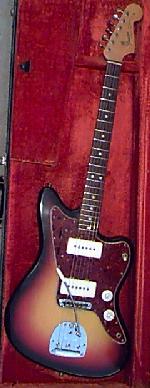
Jazzmaster Peghead Decals:
- Jazzmaster, 1962 to 1975.
1958 Jazzmaster specs:
- Alder contour body, three color sunburst finish.
- Anodized aluminum pickguard with two wide, white pickups.
- Serial number on neck plate.
- Slab rosewood fingerboard.
Mid 1959 Jazzmaster specs:
- Celluloid tortoise three layer pickguard.
Mid 1962 Jazzmaster specs:
- Veneer Rosewood fingerboard.
Late 1964 Jazzmaster specs:
- Gold Fender “transition” decal thicker than previous “spaghetti” logo (late summer 1964).
- Pearl fingerboard dots replace “clay” dots.
- Plastic tortoise three layer pickguard replaces celluloid.
Mid 1965 Jazzmaster specs:
- Volume/Tone knobs changes from a Stratocaster style knob to a unique white with chrome top Jazzmaster knob as seen here.
Late 1965 Jazzmaster specs:
- White binding on neck.
- Rectangle position markers replace dots.
- “F” style tuning gears replaces “Kluson-Deluxe” gears.
- Mid 1966 Jazzmaster specs:
Mid 1967 Jazzmaster specs:
- Peghead shape enlarged.
1968 Jazzmaster specs:
- Black Fender decal.
- Polyester thick finish replaces nitrocellulose lacquer.
- A very few Jazzmasters have Grover tuners with pearl tuner buttons.
1982 discontinued. Re-introduced Japanese 1962 Reissue in 1987.
Back to the Table of Contents
- Collectibility Rating: 1962-1965: C.
Introduced in mid 1962, this short scale (24″) guitar was (at the time) considered a high-end instrument. Actually, it was considered Fender’s top-of-the-line model until 1967 when Hendrix change everything, with his usage of the Stratocaster. Because of the shorter scale length, Jaguar values today are lower compared to other full scale models. The Jaguar’s pickups are more powerful and better shielded, which eliminated some of the hum problems associated with the Jazzmaster. The shorter (24 inch) scale was favored by some guitarists at that time, especially the surf music players. The Jaguar shared its unique rhythm circuit with the Jazzmaster. This allowed a pre-set tone for rhythm playing. However, the slide switches on the Jaguar and Jazzmaster are not easy to use while playing. They also make a lot of noise when switching settings.
The pickguard removed from a 1962 Jaguar.
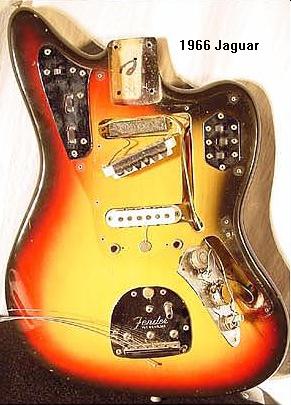
- Similar body and peghead shape to Jazzmaster, 2 white oblong Strat-like pickups with notched metal side plates, 2 knobs and 3 individual pickup switches on treble side, selector switch and 2 roller knobs on bass side, string mute, Jazzmaster type floating tremolo.
Jaguar Peghead Decals:
- Jaguar Decals, 1962 to 1974.
1962 Jaguar specs:
- Alder contour body, three color sunburst finish.
- Celluloid tortoise three layer pickguard with two Strat-like pickups.
- Serial number on neck plate.
- Veneer Rosewood fingerboard.
- Pearl fingerboard dots replace “clay” dots.
- Plastic tortoise three layer pickguard replaces celluloid.
- 1965 Jaguar specs:
1966 Fender Jaguar guitar specs:
- Binding added to sides of fingerboard by late 1965.
- “F” style tuning gears replaces “Kluson-Deluxe” gears. Note the Jaguar was the first Fender guitar model to change to “F” style gears.
1967 Fender Jaguar guitar specs:
- Block fingerboard inlays replace dots by late 1966.
1968 Jaguar specs:
- Black Fender decal.
- Polyester thick finish replaces nitrocellulose lacquer.
1975 discontinued. Re-introduced Japanese 1962 reissue in 1994.
Back to the Table of Contents
The Fender Electric XII.
Collectibility Rating: D.
- Introduced in late 1965, this model had unusual split pickups, much like a Precision bass. As with most twelve string guitars, its value is low especially compared to six string models. Designed by Leo Fender, the Fender Electric XII was introduced with the bulk of the production taking place in 1966. The model was discontinued around 1970. Unlike its competitors’ electric 12-string models, which were simply existing 6-string guitars with six more strings, the Fender Electric XII was a ground-up 12 string designed to capture part of the folk-rock market. The headstock was different from Fender’s usual 6 on-a-side shape, and is sometimes referred to as a “hockey stick”. Leo Fender’s bridge design for this model is very simple, works well, and may be one of Fender’s best designs of the 1960s. The bridge has an individual saddle for each string, allowing for precise intonation. A string-through-body design also helps to increase sustain.
Mid 1965 Electric XII specs:
- Rosewood fingerboard with pearl dots.
Late 1965 Electric XII specs:
- White binding on neck.
Mid 1966 Electric XII specs:
- Rectangle position markers replace dots.
1968 Electric XII specs:
- Black Fender decal.
- “F” style tuning gears replaces “Kluson-Deluxe” gears.
- Polyester thick finish replaces nitrocellulose lacquer.
1969 Electric XII discontinued.
Back to the Table of Contents
- Fender tweed amps from late 1955 to 1960 are considered the most collectable of all amplifiers. These tweed covered “narrow panel” amps look more like suitcases than amplifiers, and sound amazing. Value is generally based on size and number of speakers (the more powerful the amp, the more valuable). Earlier tweed amps (pre-1955 “wide panel” models and prior) are less desirable. This is because these earlier amp circuits are not as powerful, and don’t sound as good. Later “colored tolex” brown and white amps from 1960 to 1963 are also desirable, but not like the late 1955-1960 tweed models. The 1964 to 1967 “black face” black tolex models are also somewhat collectible. These amps have a black control panel with white script writing. Fender amplifiers after 1967 (“silver face” models) have no collectable value. These amps have a silver control panel with blue block lettering. Starting in the early 1980’s, Fender starting use the “black face” styling again. Sometimes these amps are confused with the 1964 to 1967 models.
TV versus Wide versus Narrow panel Tweed Amps. These are all tweed Princeton models. On the left is a “TV” front 1949 Princeton; note the speaker cutout has rounded corners. In the middle is a “wide panel” 1954 Princeton; note the speaker cutout corners are square. On the right is “narrow panel” 1959 Princeton. The “panel” refers to the height of the panel above the speaker grill, which is much narrower compared to the “wide panel” models.
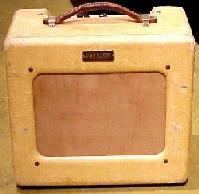
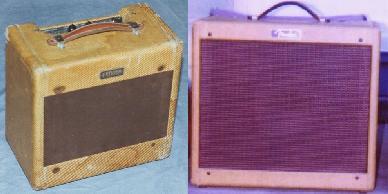
Fender Amp Types Explained.
- Fender amps produced between 1946-1948 are often called
“woodies”
- , because of the uncovered wood cabinets and matching wood handles. These cabinets came in three finishes: mahogany, maple, and walnut. The speaker grill was covered in either a red, yellow, or blue fabric with one to three chrome “slats” running from top to bottom. The controls were mounted on a rear facing control panel. At this time Fender only had three models: the Princeton, Deluxe and the Professional. There were also two dual speaker models available, the Dual Professional and the Super. These amps were available starting in 1947, and used tweed covering over the wood. They also had a single metal slat runing down the center of the brown mohair speaker grill. The cut-out for the speaker grill is rectangled on these two models. The Dual Professional model only lasted a year, where the Super stayed in production.
Fender Amps produced from 1948 to 1953 have a “TV front” shaped speaker/grill cloth area (the speaker cutout is rectangular with rounded corners and looks like an old fashioned TV). The cabinet’s wood panels were mated using “finger joined” wood, which gave a much stronger cabinet. The new joinery isn’t very pretty, so Fender covered the cabinet in a tweed suitcase material that was popular at the time. This early tweed was light colored and had a vertical pattern. Later the pattern was changed to a diagonal style with more contrast between the light and dark fibers (the exception to the tweed rule is the 1949-1950 two tone leatherette Champion 600 amp). Control panels on the TV amps were located on the top rear, facing up (except the Champion), and had a chrome finish. The speaker grill was covered in brown mohair.
From 1953-1955 Fender made a new style of cabinet called the “wide panel”, which had a rectangular speaker grill, with the corners squared. When viewed from the front, there are two wide tweed panels above and below the speaker grill, with a .75″ edge on the left and right side panels. All else was the same as the TV front amps, except the speaker grill was now a dark brown linen material.
From 1955 to 1960 (1964 for the Champ), “narrow panel” Fender amps were made. These amps look identical to the “Wide panel” amps, except the top and bottom front panels (above and below the speaker grill) were no longer wide. Now the front speaker grill was almost completely “grill”. The linen speaker grill was also replaced by genuine brown plastic grill cloth, with golden yellow highlights. The control panel was still chrome with black “chicken head” knobs, facing up. The amp handle was still a leather handle with white stitch around the edges.
In late 1959 to 1963, a new style of amp was produced by Fender. These amps, known as “browns”, were completly redesigned with an angled, forward facing, brown control panel and round brown knobs with a white indicator line. The tweed covering was replaced with a brown fabric-backed vinyl material called Tolex. This brown Tolex was reserved for the smaller Fender amps such as the Deluxe, Princeton, and Super (the larger amps used white Tolex, see below). Most of these amps still used the leather handle of the tweed amps, but the Super later converted to a brown “dog bone” plastic handle. Early brown Tolex amps had a pinkish hue, while the later browns had a rich brown color. Grill cloth on the earlier brown amps used “ox blood” (maroon) colored plastic speaker grill cloth. Later models used “wheat” or golden colored grill cloth. The control panel is brown colored, but later changed to black.
White or “blond” Tolex Fender amps were produced at the same time as the brown amps. The white (more like biege) Tolex use round white knobs on the control panel. This color scheme was reserved for the new “piggyback” amps (Showman, Bassman, Tremolux, Bandmaster) and the Twin combo. Early blonde Tolex had a rough texture, while later white amps have a smoother feel. Early white amps have brown speaker grill cloth like the tweed amps, then converted to a maroon grill cloth. The last white amps have a wheat or golden speaker grill cloth. The handle was changed from a leather unit to a black plastic “dog bone”. The control panel is brown colored, but later changed to black.
Fender amps produced between 1963-1967, known as “blackface” amps, retained the cabinet style of the brown/white amps, but were covered in black Tolex. A new reinforced black strap handle was added, and silver sparkle speaker grill cloth. The control panel was changed to black with white labels and fitted with numbered, black skirted knobs. Early blackface amps (1963) do not have white silk screening around the bright switch(es). By early 1964, the white silk screen is added around the bright switches. This was also the era when most Fender amps were fitted with built-in reverb. Because of this, the blackface amps became the “working man’s” amp. Many people today still love black faced amps because they had everything; good sound and reverb!
Left: Fender amp covers used. From left to right you
have Tweed, Brown Tolex, White Tolex.
Right: Fender grill cloth used. From left to right you
have 1955 to 1960 woven brown and gold, 1963-1964
“cane”, and 1964-1967 silver grill cloth.
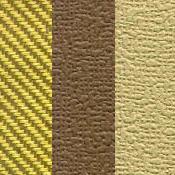
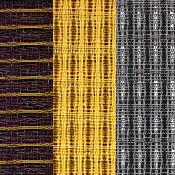
In April 1967 to October 1967, Fender amps were changed again. These amps are known as “silverface” amps. The black Tolex stayed, but the control panel was changed to a silver/chrome color with blue lettering. Also until May 1968, several black vertical lines were on the control panel, next the brightness switch(es), and on either side of the amp’s model name. The silver speaker grill cloth also had a blue sparkle added. In addition, until late 1969 an aluminum frame was added around the speaker grill (often called a “drip edge”). These amps pervailed through the 1970s and early 1980s. But from 1980 to 1982 Fender changed back to the “black face” look. These amps share the same circuits as the silver face amps, though they look like black face models. An easy way to tell these “fake” black faces from a real black face is the model name on the control panel. The word “Amp” was dropped (for example, “Deluxe Reverb Amp” became “Deluxe Reverb”). Other silverface facts include: The fist Master volume controls were installed in 1972. These are generally considered “really bad” amps. Fender also installed wheel casters on some larger amps and cabinets beginning in 1972.
It should be noted that in January of 1965, Leo Fender sold Fender Electric Instruments Co. and Fender Sales to CBS. They renamed the company to Fender Musical Instruments. Within a couple years, CBS changed the design of their amps, and not for the better. The change started in the early silver face years. Most CBS changes were put into production with the silver face models, yet some models were left almost untouched. The quality of CBS era amps (and guitars!) has always been a concern of players and collectors. Little stuff was obvious, like the misspelling “Division of Colombia Records Division” instead of “Division of Columbia Records Division” on the rear chassis panel on some amps from late 1965 and early 1966.
Amp Model Numbers/Circuit Designations on the Tube Chart.
On the tube chart, attached on the left inside wall any Fender amp, there is a model number which designates the circuit design. This number often identifies the design month and year of the circuit used in the amp. IMPORTANT NOTE: this is NOT an accurate way to date an amp. Fender often used the wrong tube chart on “new designs”. For example, Some early silverface amps with silverface circuits can have a blackface model/circuit tube chart. Another example would be a 1955 tweed narrow panel amp having a wide panel model/circuit tube chart.
1963 and later Model/Circuit numbers: In 1963 Fender began using the model name and an assigned circuit number. These circuit numbers can be useful for getting a rough date on an amp (just be aware that Fender often used the same circuit number for many years). The code is simple, the first two letters are the revision (AA is the first revision, AB is the second, etc.) The next one or two numbers are the month where January is 1 and December is 12. The last two numbers are the year. Example: AB763 = second revision, July, 1963. AA1070 = First revision, October, 1970. Again remember, a 1963 circuit could be used in a later amp 1966 amp.
1951 to 1963 Model/Circuit numbers: The model numbers used before 1963 are different. For example, model “5D8” means a 1954 Twin amp, as shown below:
The first number is the decade: 5=designed in the 1950s 6=designed in the 1960s The next character (letter) is the approximate year: A=1951 (TV front tweed) B=1952 (TV front tweed) C=1953 (wide panel tweed) D=1954 (wide panel tweed) E=1955 to 1960 (narrow panel tweed) F=1960 to 1963 (tolex era) The number(s) after the letter is the model: 1=Champ 9=Tremolux 2=Princeton 10=Harvard 3=Deluxe 11=Vibrolux 4=Super 12=Concert 5=Pro 13=Vibrasonic 6=Bassman 14=Showman 7=Bandmaster 15=Reverb unit 8=Twin 16=Vibroverb
Date of Manufacturer for Fender Amps.
First check the cosmetic features of the amp in question. The above text should ID the amp’s year into a general range of years. Next, check the date code(s). Fender amps made from 1951 to 1967 have a date code in the back. This is stamped with an ink stamp in black ink (or green ink in 1966) on the tube chart. Note this ink stamped designation should not be confused with the model number, serial number or production number. The first letter of the ink stamp is the year, the second the month of manufacturer.
First Letter (year): A = 1951 J = 1960 B = 1952 K = 1961 C = 1953 L = 1962 D = 1954 M = 1963 E = 1955 N = 1964 F = 1956 O = 1965 (black ink) G = 1957 O = 1966 (green ink) H = 1958 P = 1966 I = 1959 Q = 1967 Second Letter (month): A = January G = July B = February H = August C = March I = September D = April J = October E = May K = November F = June L = December
Note: In January 1966, Fender forgot to change the year stamp for the tube chart stamp! Because of this, early 1966 amps (January/February) have the same letter stampings as early 1965 models.Princeton Reverb Tube chart, dated January 1966
with the large ink-stamped “OA” on the right hand side.
Yes, this is the confusing “OA” date stamp, which was used
in BOTH 1965 and 1966! So, is it 1965 or 1966? Well the
give away is the “Fender Musical Instrument” trademark,
meaning this is a 1966 amp. If it said “Fender Electrical
Instruments”, it would have been 1965! Also note the model
number AA764. This means the circuit used was designed in
July 1964, and is the first revision.
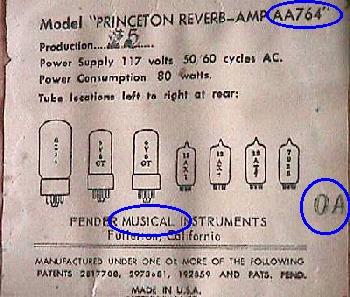
- Note the above tube chart from a 1965 Princeton Reverb amp. This chart is attached in the back inside of the cabinet, on the side wall. The rubber stamped “OA” designates the year (“O”=1965) and the month (“A”=January). But remember, for the months of January and Febrary
1966
- , Fender forgot to advance the year stamp from 1965! Actually this amp is January 1966, because of the “Fender Musical Instruments” instead of the 1965’s usage of “Fender Electric Instruments” on the tube charts. But all Fender amps from 1951 till the end of 1967 used this rubber stamp as a dating system. This stamp can also often be seen on the amplifier chasis too. Also the “AA764” specifies the date of design for this version of the circuit: July 1964. The “Power Consumption 80 watts” is how much power the amps consumes (a little more than a 75 watt light bulb), and
not
- the output rating! This particular amplifier only outputs about 12 watts RMS.
If an amp doesn’t have a date code, check the transformers and speakers for their manufacturer codes. Also the chassis can be removed, and a few of the pots and capacitors checked for manufacturer codes (assuming these components are original!) See here for more info.
More date info on 1960s and later Fender Amps: According to Greg Gagliano, Starting in the 1960s, many blackface and later amps were stamped with another style of date code, on the inside of the chassis. These read something like F034267 (where “67” denote the year, and the “42” before it denotes the week) or F07 668 (where “68” is the year, and “6” before it is the week). This system was continued on the silverface amps, some of which have the stamp on the underside of the chassis (where you can see it easily) in addition to the stamp on the chassis interior. In the late 1970s and early 1980s, the chassis date stamp became more cryptic. For example, a chassis stamp of 1831 must be read backward to reveal the date, in this case week 13 of 1981. This is very useful information in the absence of a tube chart date code (after 1967), or if the tube chart is missing.
The date stamp on the bottom of a Pro Reverb. The stamp
“F07 668” indicates the 6th week of 1968.
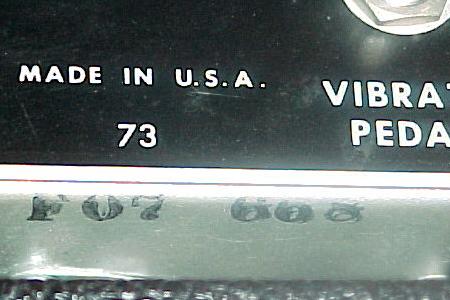
“Fender Electric” versus “Fender Musical”.
- During the summer of 1965, Fender amps changed their trademark name from “Fender Electric Instruments” to “Fender Musical Instruments”. This makes identification of the early 1965 verus early 1966 amp very easy (1965 amps say “Electrical”, 1966 amps say “Musical”), in the case of OA and OB dated amps, where Fender forgot to change the year stamp.
Early Silverface Circuits.
Cosmetics aside, early silverface Fender amps can often have the same circuit as their blackface cousins. The date of the change from the blackface circuit to the CBS silverface circuit was dependent on the exact model. But most amp model circuits were modified by mid 1968.
Of course, the most foolproof to determine if an early silverface amp uses the older blackface circuit is to pull the chassis and look at the layout. But according to Greg Gagliano, on the 40-watt and 80-watt amps, simply pull the chassis out about 2 inches and look for the big ceramic power resistors. These are connected to ground from the cathode (pin 8) of the power tubes. If those resistors are there, the amp has the evil CBS silverface circuit.
Remember not all early silverface amps (with a black line control panel and silver speaker drip edge) have the blackface circuit. The except would be smaller amps, mainly the Vibrolux Reverbs, Deluxe Reverbs, Princetons, Princeton Reverbs, Champs and Vibro Champs.
Fender Amp Wiring.
Sometime in late 1968, the cloth covered wire used in Fender amps from 1946 on changed. Fender transitioned from cloth wire to thick PVC wire (in pastel greens, white & yellows).
Cabinet Construction. Info by Greg Gagliano.
From 1946 to about 1972, solid pine, finger-joined cabinets were used in Fender amps. An interesting feature on the tweed-style cabinets is the use of a dowel reinforcement in the top on either side of chassis. You can’t see the dowels unless the tweed covering is removed, but this reinforcement prevented the wood from splitting due to the weight of the chassis.
Speaker baffle boards were made of plywood from 1946 to 1962. Particle board (some call it MDF – medium density fiberboard) baffles debuted in 1963 and were used through the early 1980s. The baffle board was removable on amps made from 1948 to about 1972 and glued-in thereafter.
From circa 1972 to the early 1980s, the cabinets were no longer made from solid pine boards, but cheaper laminated, multi-piece pine boards. Each side of the cabinet was made from several pieces about three or four inches wide, glued side-to-side, to make up a plank the depth of the cabinet. These laminated cabs were not finger joined, but rabbet joined. The baffle board on these rabbet joined cabinets was mortised into the sides and bottom (i.e. – not removable) to hold the whole thing together. That’s why these post-1972 cabinets have the grill cloth stretched across a frame that is attached by a velcro-like system to the baffle. CBS almost certainly went to this construction method to save money, though at the expense of overall quality.
Fender Amp Speakers. As quoted from Greg Gagliano.
Jensen was the prevalent stock speaker in Fender amps from 1946 through about 1961. As the story goes, Leo Fender wanted Jensen to make some changes to speakers and either the speaker couldn’t (price constraints?) or wouldn’t do so. That’s when Fender switched over to Oxford as the standard speaker (though Jensens were still used from time to time). In late 1965, Fender (CBS) again started using Jensen spekaer. These Jensens wear a brown and gold “Fender by Jensen” label and were put into Fender amps beginning in late 1965 through about mid-1967.
Note Jensen Vibranto LI and MI series speakers (alnico magnets) and Jensen EM-series speakers (ceramic magnets), were not used by Fender. They are were often sold as replacements for blown speakers which is probably one reason why they are seen in Fender amps. The Vibranto LI series speakers had a lifetime warranty and it seems that Jensen went out of the musical instrument speaker business just in time to avoid the claims. All speakers can and will fail eventually.
Jensen speaker models denote their approximate power handling capacity and magnet type. The R, S, and T suffixes denote a low power rating good for Princetons and Champs, but the R is barely able to handle the power of a Deluxe. The Q and P suffixes denote a medium power rating. These are especially good for multi-speaker amps up to 40-watts since multiple speakers divide the amp’s total output power between them. For this reason, the P10Q is the speaker to have in the 5F6-A Bassman. Note that it does not appear that Fender used the “P” rated speakers very often. The N and LL suffixes denote a high power rating, with “high power” being a relative term. The P12N, on a good day, can handle 20 watts. It’s no wonder that 80-watt Twins easily shredded a pair of them. Note that Fender did not use the “L” rated speakers (but Ampeg and Leslie did).
Oxford: Greg Gagliano continues… Oxford speakers codes work in a similar fashion, but it is the letter that denotes power handling. The higher the letter, the higher the power rating: K = 25 watts, L = 30 watts, M = 40 watts, and T = 45 watts (12″ speaker) or 60 watts (15″ speaker). It is important to note that these are peak power ratings, not RMS power. The RMS rating is more realistic and is usually about half of the peak rating.
The “J” rated speakers are usually found on 12-watt Princetons. The “K” rated speakers are found in reverb and non-reverb Deluxes and in multi-speaker amps up to 40-watts such as the Tremolux and Concert. The “L” rated speakers are found in reverb and non-reverb Deluxes, some Tremolux amps, and multi-speaker amps like the blackface Concert, Super Reverb and Vibrolux Reverb. The “M” rated speakers had good service life in the piggyback Bassman and Bandmaster amps, but were easily blown in blonde Twins. The “T” rated speakers were standard in Twin Reverbs, but like the Jensen C12Ns, they often had a short service life.
Generally speaking, Oxford speakers found in Fender amps from 1965 through the 1970s are not as desirable as their Jensen counterparts. The gap distance was increased in the Oxfords that Fender used later in the decade and this reduced their efficiency (and they were cheaper to make this way). I’ve heard many great sounding Fender amps with Oxfords. I will admit that I prefer Jensens, but I’ve never let an Oxford speaker sway my decision from owning a Fender amp. Additionally, the Oxfords from early ’60s generally sound very good. According to noted vintage amp specialist Gregg Hopkins, these early Oxfords were constructed similarly to Jensens from that period with respect to materials and voice coil gap. That could explain why they sound good.
CTS: CTS (Chicago Telephone Supply) speakers were used occasionally in Fender amps until the mid-1960s. These are good quality speakers that tonally lie between Jensens and Oxfords. The alnico 10-inch CTS speaker was the most prevalent speaker in Super Reverbs from the mid-1960s through the 1970s.
Utah: Fender didn’t use Utah speakers very much until the 1970s. The Utah speakers from the ’50s sound very good and I’ve heard a killer ’66 Super Reverb that was equipped with factory original Utahs. Generally, the Utah speakers of the ’70s weren’t as great sounding as their predecessors.
JBL: JBL speakers were optional (at additional cost) for nearly all models from 1960 to about 1980. JBL D-series speakers had orange baskets and Fender by JBL labels in the 1970s. JBL D-series speakers can generally handle upwards of 60 watts each. A pair of JBL D-120Fs in a Twin Reverb are only seeing about 40-watts each (no sweat), but remember that no speaker likes to see square waveforms. So, driving the Twin with any amount of distortion lowers the power handling capacity of the speaker, which makes any speaker more susceptible to damage even a high-wattage type like the JBL.
Eminence: Eminence has its roots in CTS (Mr. Gault left CTS to found Eminence) and many of the early Eminence designs are similar or identical to CTS speakers (good examples of the similarities can be found in mid-1970s Ampegs). Fender began using Eminence speakers as standard in nearly all of its tube amps beginning in the early 1980s. These are generally made to Fender’s specifications and in some cases, such as the reissue ’65 Twin Reverb, the speakers were designed to emulate the Jensen C12N speakers which were often found in the original ’65 Twin.
General Amp Timeline Specs.
1946 Amp specs:
- All combo amps (no piggyback models).
- Hardwood cabinets.
- “TV” style (oval) front speaker panel.
- Knobs on back of amp.
1948 Amp specs:
- Grill cloth is burlap type material.
- Tweed “vertical” covered material, sprayed with nitrocellulose lacquer.
- knobs on top of amp.
- “TV” style (oval) front speaker panel.
Mid 1953 Amp specs:
- “Wide Panel” rectangle front speaker panel (portion above speaker wide).
- Tweed “diagonal” covered material, sprayed with nitrocellulose lacquer.
Late 1955 Amp specs:
- Grill cloth is woven brown and gold plastic material.
- “Narrow panel” rectangle front speakers (portion above speaker narrower).
- These varients of Fender amps (late 1955 to 1960 narrow panel tweeds) are generally the most collectible.
Left: Mid-1963 white tolex Bassman head. Notice the flat “Fender” logo, the “cane” grill cloth, and the brown control panel with white script writing.
Right: Late-1963 Bassman head. Notice the control panel is now black, not brown.
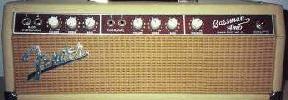
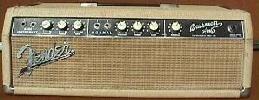
- Tolex covering replaces tweed.
- Champ retains tweed covering until 1963.
- Maroon plastic grill materials replaces brown/gold.
- Brown tolex for Super, Concert, Pro, Vibrosonic, Princeton, Deluxe.
- White tolex for Twin, Bandmaster, Tremolux, Bassman.
- Bandmaster, Tremolux, Bassman become two piece amps (separate head and speakers).
- Knobs mounted on front of amp.
- Knob panel brown with white script lettering.
- Larger brown and white tolex amps have a flat “Fender” logo.
- Smaller amps (Deluxe, Princeton, Champ) have no logo.
- 1960 Amp specs:
1963 Amp specs:
- Reverb introduced on the (brown tolex) Vibroverb amp.
- Separate reverb unit available in either brown or white tolex.
- Gold “cane” grill material replaced maroon.
- Knob panel black with white script lettering (late 1963).
1964 Amp specs:
- Larger brown and white tolex amps have a non-flat “Fender” logo.
May 1964 Champ amp. Notice the old style
tweed wooden case, covered with black tolex.
Fender only only did this for a short time.
They must have run out of tweed before they
converted to the newer style champ cabinet.
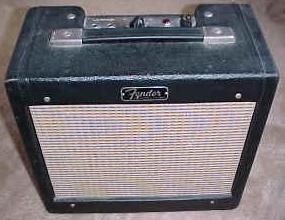
- Black tolex replaces brown, white, or tweed on all models.
- Reverb added to all mid to high end amp models. Some models (like the Deluxe and Princeton) reverb is an option and is not standard.
- Silver grill material replaces cane.
- Mid 1964 Amp specs:
1965/1966 Amp specs:
- The “O” year code stamp used on the tube chart is mistakenly not reset to “P” in January 1966. So an amp stamped “OA” could be either 1965 or 1966!
April 1967 to October 1967 Amp specs:
- Knob panel silver with blue block lettering.
- Thin vertical blue line woven into the silver grill cloth.
- Many models have a 1/4″ wide silver trim added around the grill.
- Date code no longer stamped on tube chart by 1968.
Most Fender amp models are still in production today in different forms.
- Introduction
- Serial Number/Year Identification
- General Fender Parts & Detail Specs
- Fender Cases
- Fender Custom Colors
- Reissue and Original Fender Vintage Parts Comparison
- Models: Fender Electric Model Info
- Models: Fender Acoustic Flattop Info
- Inside a 1954 Fender Stratocaster.
- Inside a 1958 Fender Jazzmaster.
- Fender Electric Guitar Schematics
- Vintage Fender Guitar Pickup Specs
- Fender Amplifiers

